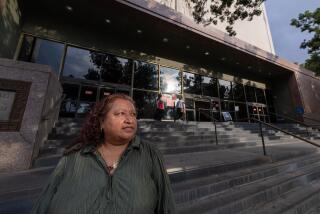Trial and Error Help Dispute-Resolution Firm
- Share via
John Horn and his partner, Angela S. Haskins, met while working for an arbitration association. The two attorneys started their own company after Horn developed a business model that he thought provided great service and pricing for the retired judges and attorneys who act as arbitrators, mediators and referees in the alternative dispute-resolution arena, which provides an increasingly popular alternative to court trials. However, it was not easy to convince potential clients that his firm--which handles administrative functions and markets the judges’ services--really had a “better mousetrap.” Horn spoke to freelance writer Karen E. Klein about patience and changing tactics when necessary.
*
I got an MBA after an unsuccessful attempt at law school right after I graduated from UC Berkeley. Ten years later, I returned to law school, attending Loyola at night while working at an arbitration association during the day. I had been there all of a month when I walked into my boss’ office and stated that the association was doing it all wrong. I explained my business concept to her, she politely listened and then told me to get out of her office and get back to work.
I continued to develop my plan while bouncing it off a very popular retired judge, and I left the association a year later to start ADR International Inc. Ironically, my skeptical boss was Angela Haskins, who left the arbitration association just over a year after me and has been my business partner ever since.
What I had discovered from observing the alternative dispute-resolution process is that attorneys choose the judge that they want to hear their case based on the judge’s reputation and personality, not on the organization that represents him or her. The organizations that represented these judges were literally spending millions of dollars to brand their name and services, when in reality the marketplace was interested in the individuals they were representing, not in the providers themselves.
My concept was simple: To outsource all the administrative functions that a judge would need, performed by attorneys rather than clerks, and to put all our marketing efforts behind the individuals we represented, ultimately adding to their stature in the marketplace.
We would help design the judge’s advertising, provide upscale hearing facilities, and even answer the phone with: “Judge X’s office.” Our primary appeal would be that we would only charge 10% to 15% of their hourly billings, as opposed to the 35% to 65% charged by traditional ADR providers.
My plan was to make money by capitalizing on economies of scale. Our goal is to generate $5 million in client billings so that our 15% ($750,000) in revenue would give us roughly a 50% profit margin.
Unfortunately, the first lesson we learned was that financial logic does not convince. My original plan was to persuade very popular judges, who were requested frequently for ADR work, to turn their business over to me. I created comparison charts showing how much money I could save them, while also limiting their financial liability and increasing flexibility. However, even though the numbers were compelling, not a single one of the judges I originally targeted came on board.
There were two reasons for this: They were comfortable in their practices and reluctant to change, and they did not see the value of our model.
We spent a lot of time analyzing why the top judges were not beating a path to our door. To generate revenue, we began taking clients who did not have much business. Although this created a tremendous amount of work, it brought in little money because we are paid on a percentage basis and our clients were not billing a lot.
Finally, after more than two years, we landed our first “star” client, who accounted for more than 60% of our revenue. Our business model proved true, and he became our success story. We tried to leverage him to get new clients, but still most were reluctant to change.
The important thing to us is that we proved our model will work, and we have never considered changing it since.
Because we work on such thin margins, we needed to make sure that every future client would also be a star, and we had to abandon the idea of attracting existing stars and instead try to catch judges just coming off the bench into ADR, before they became comfortable.
We also learned that in a service business, people buy from people. We have been able to grow our business through our own personal development as leaders in the marketplace. For example, although our clients like the fact that we are licensed attorneys, they really like that I am now teaching ADR at Loyola Law School. We are also involved in a large number of industry-related projects and associations.
The final, and toughest, lesson we learned was to be patient. I knew that I could have been making a lot more money by practicing as an attorney. And as I took out second and third mortgages on my house to keep things afloat, I had lots of incentive to pack it in. However, I determined that I was not going to quit.
Today, we manage the practices of several top judges and attorneys with annual client billings of roughly $2.5 million. In April, we moved to larger offices, doubling our space, and have begun working with four new judges since the beginning of the year.
*
If your business can provide a lesson to other entrepreneurs, contact Karen E. Klein at the Los Angeles Times, 1333 S. Mayflower Ave., Suite 100, Monrovia, CA 91016 or at kklein6349@aol.com. Include your name, address and telephone number.
(BEGIN TEXT OF INFOBOX / INFOGRAPHIC)
AT A GLANCE
Company: ADR International Inc.
Owners: John Horn and Angela S. Haskins
Nature of business: Provide administrative services for dispute resolution professionals
Location: 11835 W. Olympic Blvd., Suite 375
Founded: 1995
Employees: 2
Web site: https://www.resolveitnow.com
E-mail: hornadr@aol.com
Annual revenue: $230,000
More to Read
Inside the business of entertainment
The Wide Shot brings you news, analysis and insights on everything from streaming wars to production — and what it all means for the future.
You may occasionally receive promotional content from the Los Angeles Times.










